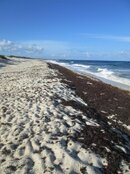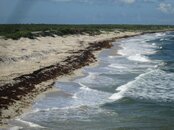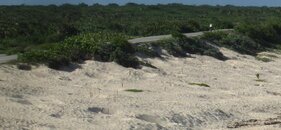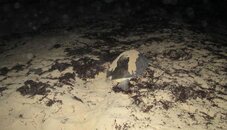El Graduado
Contributor
- Messages
- 833
- Reaction score
- 1,666
even if there is no change in the nests it may be a problem for the hatchlings to navigate through the sargasso on the beach.
I decided to go look again at the east side with an eye out as to whether or not the seaweed was any impediment to the turtles laying eggs there. Below are some photos of the beach between Punta Morena and Chumul (that is the name of the hill that Coconuts and Ventanas al Mar occupy).
You can see in the photograph #1 and #2 that there is a lot of Sargasso, but you can also see in the enlarged portion of the image #2 that there are also a LOT of new turtle nests. Each red stick marks one nest. There are dozens in the enlarged portion image and several hundred in the large original image .



Next, we talked to the night watchmen at Ventanas al Mar Hotel. They said there were between five and ten turtles every night laying eggs within view of the hotel’s restaurant balcony. We decided to see for ourselves.
Last night, around 9PM, the turtles started coming up on the beach to lay eggs. They seemed to have absolutely no trouble at all with the Sargasso. In fact, it looked to me that that was the easiest part for them; imagine hauling a full ice chest across the sand of a beach. Now imagine dragging that same ice chest across a grassy lawn. That is what it looked like. They could get a grip with their flippers in the Sargasso, the slide across it with no problem. When they scuttled across the sand, their flippers often lost grip and flung sand up in the air.

We asked the watchmen about the hatchlings. They said they have been hatching out every evening fairly early, and make it to the water with no problem. A few get disorientated right out of the hole for some reason and head towards the dunes before turning around and then making it to the sea. A couple of these goofy ones end up in the swimming pool for the night, before the groundkeeper nets them out in the morning and sends them on their way.
Anyway, it seems to me that the turtles (large or small) are not too much bothered by the Sargasso. The newest studies that found out where the new turtle hatchlings spend their “lost years” say it is in the Sargasso Sea. Apparently, the temperature there is around three to four degrees higher in the floating Sargasso, so the small, cold-blooded turtle’s metabolism is revved up by the added warmth and they grow faster in that food-rich environment. So I guess they maybe have some sort of genetic predisposition to finding that sort of floating Sargasso in the mid-Atlantic, and if they do, perhaps Sargasso does not look so much like a barrier to them, but rather something vaguely familiar in their little turtle brains!



